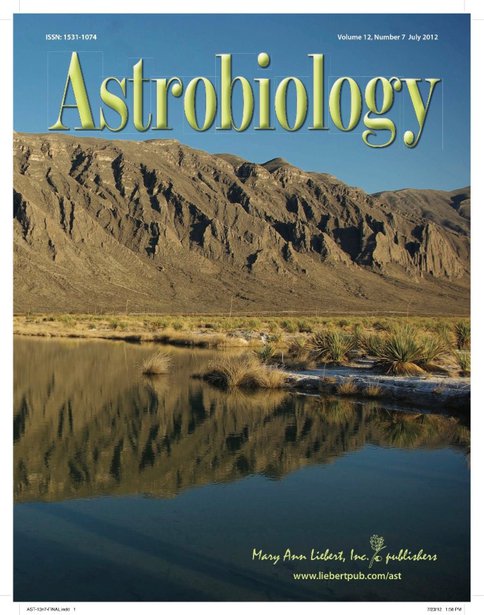2012 Annual Science Report
 VPL at University of Washington
Reporting | SEP 2011 – AUG 2012
VPL at University of Washington
Reporting | SEP 2011 – AUG 2012
Stromatolites in the Desert: Analogs to Other Worlds
Project Summary
In this task biologists go to field sites in Mexico to better understand the environmental effects on growth rates for freshwater stromatolites. Stromatolites are microbial mat communities that have the ability to calcify under certain conditions. They are believed to be an ancient form of life, that may have dominated the planet’s biosphere more than 2 billion years ago. Our work focuses on understanding these communities as a means of characterizing their metabolisms and gas outputs, for use in planetary models of ancient environments.
Project Progress
In January 2012, Siefert traveled to Irapuato, Mexico to work with the Mexican collaborators. Plans for the upcoming experiments and target sequencing efforts applicable to the goals of the project were discussed and fleshed out. This meeting also included work on manuscripts for the upcoming Astrobiology journal and planning for field excursions to CCB. In May, Siefert worked with all collaborators from the VPL team and the ASU Follow the Elements team looking at stoichiometric constraints in the Churince work site. All the bioinformatics and computational researchers met during this trip, coordinating all data input that is being generated, and now have an extensive pipeline for the enormous amounts of sequencing data that ends in a robust suite of analysis foci.
Additionally, collaborative efforts with the local and state government in Coahuila as they opened a molecular biology lab in the Cuatro Ciénegas high school were part of this field trip. This was important as the facilities will be coordinated with the VPL team’s research efforts, especially in long-term monitoring and experimentation when we are not at the site.
In August, the issue from Astrobiology journal was dedicated to the research being performed at Cuatro Ciénegas, Mexico.
This research was also written up in Discovery News: http://news.discovery.com/space/we-may-have-already-colonized-mars-120831.html
Churince Intermediate Lagoon at the Cuatro Ciénegas Basin (CCB) in Coahuila, Mexico, on a rare windless afternoon (photo taken by Luis E. Eguiarte, February 18, 2012). The gypsum rich soil and associated arid vegetation here are dominated by sotol (Dasilyrion) plants; in the background, the Sierra de San Marcos rise from 765 in the valley to 2320 meters above sea level, a steep ascent of less than 12 km.
This picture depicts some of the features that make CCB an interesting region in which to study microbiology, evolutionary biology, and astrobiology. This is an oasis of high diversity and endemism in the middle of the Chihuahuan desert and represents a locality where ancient biota with marine affinities have survived despite a long history and a complex geology, including plate tectonic activity (see the Sierra San Marcos convoluted strata in the picture) and the rising of the Mexican high plateau.
This issue includes a collection of studies in which the diversity, evolutionary characteristics, and uniqueness of CCB bacteria are discussed. Also, of great relevance for the study of astrobiology, we examine this region’s parallelism with the Curiosity probe landing site and Crater Gale on Mars, a locale rich in gypsum with similar geological features to CCB.
Publications
-
Nitti, A., Daniels, C. A., Siefert, J., Souza, V., Hollander, D., & Breitbart, M. (2012). Spatially Resolved Genomic, Stable Isotopic, and Lipid Analyses of a Modern Freshwater Microbialite from Cuatro Ciénegas, Mexico. Astrobiology, 12(7), 685–698. doi:10.1089/ast.2011.0812
-
Siefert, J. L., Souza, V., Eguiarte, L., & Olmedo-Alvarez, G. (2012). Microbial Stowaways: Inimitable Survivors or Hopeless Pioneers?. Astrobiology, 12(7), 710–715. doi:10.1089/ast.2012.0833
-
Souza, V., Eguiarte, L. E., Travisano, M., Elser, J. J., Rooks, C., & Siefert, J. L. (2012). Travel, Sex, and Food: What’s Speciation Got to Do with It?. Astrobiology, 12(7), 634–640. doi:10.1089/ast.2011.0768
-
Souza, V., Siefert, J. L., Escalante, A. E., Elser, J. J., & Eguiarte, L. E. (2012). The Cuatro Ciénegas Basin in Coahuila, Mexico: An Astrobiological Precambrian Park. Astrobiology, 12(7), 641–647. doi:10.1089/ast.2011.0675
- Elser, J.J., Corman, J.R., Lee, Z., Siefert, J.L., Bastidas, M., Cuassolo, F., Laspoumaderes, C., Souza, M.S., Balserio, E.G. & Modenutti, B.E. (2012). Life on Floating Pumice. 2012 ASLO Aquatic Sciences Meeting. Lake Biwa, Otsu, Shiga, Japan.
- Siefert, J.L., Souza, V., Eguiarte, L. & Meadows, V.S. (2012). What Could a Whole Earth Stromatolite Catalogue Tell Us?? 2012 ASLO Aquatic Sciences Meeting. Lake Biwa, Otsu, Shiga, Japan.
-
PROJECT INVESTIGATORS:
-
PROJECT MEMBERS:
Robert Blankenship
Collaborator
Eric Boyd
Collaborator
-
RELATED OBJECTIVES:
Objective 4.1
Earth's early biosphere.
Objective 4.2
Production of complex life.
Objective 5.2
Co-evolution of microbial communities
Objective 5.3
Biochemical adaptation to extreme environments
Objective 6.1
Effects of environmental changes on microbial ecosystems
Objective 6.2
Adaptation and evolution of life beyond Earth

